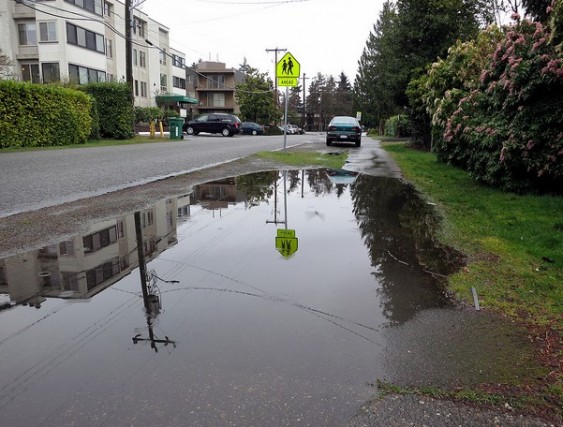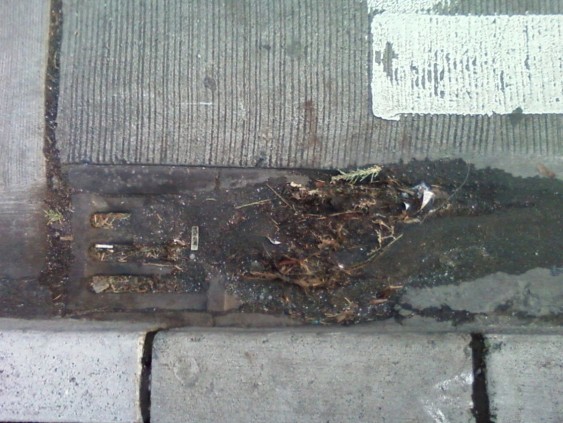Roadside rain gardens are, for the most part, enormously popular. Yet after a recent faulty installation in Ballard, which was later corrected, some folks have begun loudly criticizing them as a threat to health, safety, and quality of life. Check out the comments section on Lisa Stiffler’s recent blog post, Rain Garden Backlash is All Wet, for a good example of the controversy.
I don’t want to minimize the concerns that some neighbors have. That said, I do think it’s useful to remind ourselves that the status quo isn’t exactly wine and roses. The system we have now is aging, challenging to maintain, prone to frequent failure—and fixing it with conventional technology will be extremely expensive.
For example, it never seems quite fair to me that people grouse about the mere possibility that a rain garden might contain standing water for a day or two after a heavy downpour when the system we have now looks like this:

And this:

Now, I’m not saying that deep standing water is what we should aspire to—far from it—but it’s useful to remind ourselves that the existing system is much worse than even the worst rain garden installation.
Yet the failures of the conventional system don’t result in neighborhoods plagued by West Nile virus or hordes of rats—the sort of things that critics say rain gardens could mean.
Will children be at risk of drowning in rain gardens as opponents allege? It seems highly unlikely given that children do not presently drown in the much deeper and more dangerous pools of water created by the existing system. (Though let’s not forget that the failures of the existing stormwater system resulted in a tragic death in Seattle’s Madison Valley neighborhood when a resident’s basement was flooded with runoff that couldn’t drain properly.)
Will rain gardens present challenges for maintenance and upkeep? Perhaps. It’s a perfectly legitimate concern, although it’s hardly unique to newfangled water management technologies like rain gardens.
Here’s an example of what the maintenance on the existing drainage system looks like:

Seattle’s utility already calls on neighbors to “adopt a drain” to keep the old conventional system functioning. In that context, a little community-spirited upkeep of rain garden infrastructure hardly seems unreasonable.
While concerns and worries about roadside rain gardens deserve serious answers, it’s useful to benchmark their performance and risks to the conventional system we have now. Rain gardens, like any technology, are not a panacea. But they almost certainly do represent an improvement.
Consider that while our aging system of pipes and drains is mostly successful, its failures can be spectacular. As in Spokane last winter:
Melting snow and rain left deep standing water on some area highways… forced the closure of Prairie View Rd. Authorities estimated the pool of water to be 400 feet long and 150 feet wide.
Or in Everett:
On Nov. 23, the city released an estimated 25 million gallons of untreated sewage and stormwater straight into the Snohomish River and Port Gardner. If it hadn’t, the city risked an uncontrolled spill that could have sent even more waste into a nearby wetland and damaged the sewage plant.
“We could have had something catastrophic,” public works Director Dave Davis said.
Unfortunately, maintaining and improving the existing system is proving very costly. As an article in the Seattle Times pointed out:
King County’s $711 million plan pencils out to a wastewater rate increase for a typical customer of $7.61 a month by 2030. Seattle’s plan costs $500 million and would raise rates by $7.41 a month by 2025 for a typical single-family customer. Seattle residents would pay both increases.
Given the costs, hazards, and pollution from the existing system, I think it’s time for Northwesterners to get serious about new low-impact development technologies.
Often proving to be more effective and less expensive than conventional means of managing runoff, roadside rain gardens are a part of the low impact development solution. They won’t usher in utopia—and they won’t fix all our stormwater problems—but it’s good to remember that rain gardens are all over the region, they’re quite popular where they exist, and they are making documented improvements to our cities.
Thanks to Seattle resident David Jacobson for research assistance.

Comments are closed.